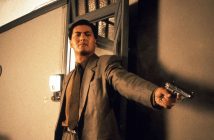 Considering that it’s among the most influential of all Hollywood westerns and the last great film directed by the ultimate American classicist, John Ford, “The Man Who Shot Liberty Valance” is quirkier and darker than you might expert. It features two great stars playing characters initially decades older, and later decades younger, than their actual ages, and has a moral and political point of view that resonates with the most complex moments in American history, including the one we’re in now. Coming from a director famed for awe-inspiring vistas, it is so small in visual scope that it is often referred to as a “chamber western.” Though it was made at a point where color had become the Hollywood standard, it was shot in black and white – and had to be. For one thing, the nearly absurd age differences between the two male leads, and their characters throughout the film, would have been ruinously obvious in color – but also because black and white has always somehow been appropriate for portraying films about moral gray areas, and that’s where this tale lives.
Considering that it’s among the most influential of all Hollywood westerns and the last great film directed by the ultimate American classicist, John Ford, “The Man Who Shot Liberty Valance” is quirkier and darker than you might expert. It features two great stars playing characters initially decades older, and later decades younger, than their actual ages, and has a moral and political point of view that resonates with the most complex moments in American history, including the one we’re in now. Coming from a director famed for awe-inspiring vistas, it is so small in visual scope that it is often referred to as a “chamber western.” Though it was made at a point where color had become the Hollywood standard, it was shot in black and white – and had to be. For one thing, the nearly absurd age differences between the two male leads, and their characters throughout the film, would have been ruinously obvious in color – but also because black and white has always somehow been appropriate for portraying films about moral gray areas, and that’s where this tale lives.
Adapted by James Warner Bellah and Willis Goldbeck from a story by Dorothy Johnson, “Liberty Valence” opens sometime near the turn of the 20th century. The aging and highly distinguished Senator Ransom Stoddard (James Stewart), who rose to fame for a now legendary moment of heroism, and his wife, Hallie (Vera Miles, “Psycho”), return to the western town of Shinbone. They are there for the funeral of an old friend, a little-known resident who died penniless. After the Senator is accosted by a self-important newspaperman (Denver Pyle) demanding to know the significance of the dead man, the bulk of the film is told in flashback as a much younger Stoddard’s stagecoach is waylaid just outside of Shinbone.
The idealistic young attorney with a true belief in the rule of law is brutalized by the sadistic, whip-wielding highwayman, Liberty Valance (Lee Marvin, in a star-making role). Near death, his beaten body is found by Tom Doniphon (John Wayne), a rancher and gunman with a decent respect for morality but a natural contempt for the law as practiced on the frontier. With Doniphon’s help, Stoddard is nursed back to health and befriended by the young Hallie, a sharp-tongued and intelligent woman despite her complete lack of education, who everyone assumes will eventually marry Doniphon. The budding love triangle plays single fiddle to the true conflict between Stoddard and Doniphon: the gun-toting tough guy is certain that the only way to deal with a man like Valance is with brute force, while Stoddard, the eastern tenderfoot, is equally certain that the only proper and correct way to deal with the likes of Valance is through the offices of the law. Considering that the entirety of local law-enforcement is a comic-relief coward with a touch of morbid obesity (Andy Devine), and that Valance and his psychotic hooligans (Lee van Cleef and the great Strother Martin) are in the pay of the local powers-that-be, Stoddard’s commitment to rule of law could be seen as just about suicidal.
As I write this, the United States is going through a three or four-sided battle over the issue of torture and the law. At one end, respected lawyer/commentators like Glenn Greenwald and Jonathan Turley are leading the charge for strong investigations of the prior administration for committing war crimes, but are also on the attack against the current administration for behavior they see as insufficient in the pursuit of justice, or even in some ways complicit with past evils or creating opportunities for new ones. Never has law and order been as hot an issue on the more liberal end of the American spectrum, and never have so many random blog commenters posting emphatic comments demanded 100 percent compliance with the law. I’m a liberal blog denizen myself and highly sympathetic to the cause overall, but some of these online crusaders seem to lack any awareness of the messiness of life or the moral compromises involved in history and daily life. Greenwald in particular often lacks both a sense of humor and, though perhaps I expect too much, a sense of tragedy.
Fortunately, John Ford’s films had enough comedy and tragedy to stretch well beyond their creator’s death in 1973, and while it is an unusually messy Ford film, “The Man Who Shot Liberty Valance” is, with the exception of “Unforgiven,” probably the single most morally mature western ever made. It sets up an ethical quandary that can only be resolved with a lie of historic proportion. As the film’s most famous line has it, “When the legend becomes fact, print the legend.” The film doesn’t endorse this point of view, it merely acknowledges the inevitability that beautiful lies will always overpower brutal or drab truths – but also that there can be a kind of personal honor even surrounding those lies and the complicated relationships they foster.

Though he is second billed, and not only because Wayne was the bigger draw, James Stewart is the film’s protagonist and is never off-screen for long. Stewart may be my favorite all-time movie star, and this is a solid performance. However, his character’s strident sense of righteousness comes at a price, and there is a reason we tend to side with his romantic rival and de facto teacher in the ways of the west. John Wayne’s Tom Doniphan is nearly as smug in some ways as Stewart’s legal eagle, but his tragic charisma in the face of a deadly bargain with his own sense of honor makes this one of the Duke’s most affecting performances, even if, like Stewart, he is a man in his mid-50s playing a 20-something tough guy. (John Ford could be almost stupidly perverse in this regard. He also cast lanky 51-year-old O.Z. Whitehead as a dimwitted schoolboy.)
Nevertheless, the best performances in “The Man Who Shot Liberty Valance” come from its two more age-appropriate stars. Vera Miles (“The Wrong Man,” “Psycho”) gives a marvelously layered performance as a woman honestly, and probably permanently, torn between a noble gunslinger and a somewhat pompous and inglorious idealist. More famously, Lee Marvin begins a string of indelible performances playing one of the most killable bad guys to ever disgrace a western street. As different as they are in just about every way, there are definite thematic thinks between “Liberty Valance” and “Deadwood” – but the true link between them is Lee Marvin’s brutal smile.
John Ford, who had already directed nearly 140 films, was pretty much a movie anachronism by 1962. Despite Gene Pitney’s memorable hit version of Burt Bacharach and Hal David’s title song, which Ford (correctly) refused to put in his film, “The Man Who Shot Liberty Valance” was a box-office failure on its release, and critics were underwhelmed. Movie westerns were on their way out, killed partially by a plethora of dull TV westerns. But as the era of all westerns has receded, it’s reputation has grown along with its fame and influence, starting with TV and nightclub impressionists who invariably had John Wayne address people as “Pilgrim” – Tom Doniphon’s entirely accurate nickname for Ransom Stoddard. As the cynical and violent westerns of Sergio Leone and Sam Peckinpah became the new standard for the genre, John Ford’s chamber western was just old fashioned enough to be comforting, while being just ironic enough to be credible. Its ultimate greatness comes from a deeper place, however, and John Ford’s final masterpiece proves that irony and sincerity are not enemies.
4.5 / 5 Stars
Starring: John Wayne, James Stewart, Vera Miles, Lee Marvin, Edmund O’Brien, Andy Devine, Woody Strode, Jeanette Nolan, John Qualen, John Carradine, Ken Murray, Strother Martin
Director: John Ford
Theatrical Release Date: April 22, 1962
Centennial Collection DVD Review:
As usual with Paramount’s series of reissued classics, the technical quality of the DVD is solid, preserving the high contrast and rather un-pretty look employed by John Ford and cinematographer William H. Clothier. As a lover of the sound of classic “hi-fi,” I’m happy to say also that the 5.1 surround track does a solid job of mimicking what you might have heard in a really nice movie theater back in the day. As for extras, Disc One includes a commentary from director-actor and film historian Peter Bogdanovich, supplemented by audio recordings of interviews with Ford, Stewart, Wayne and Lee Marvin. I’ve had extremely mixed to downright hostile reactions to some of Bogdanovich’s past commentaries, but I’m recommending this one as he does a solid job of illuminating the film’s complex place in film history, and it’s equally complex view of world history – even if he does so in a near whisper. There’s also a selected scene commentary with Dan Ford, the director’s grandson, augmented by audio recordings by the younger Ford, including some of the same clips used in Bogdanovich’s commentary. Those same interviews are used for a third time on “The Size of Legends, the Soul of Myth,” the sole significant extra on Disc Two. It’s an interesting enough documentary on “The Man Who Shot Liberty Valance” and its lasting influence.


